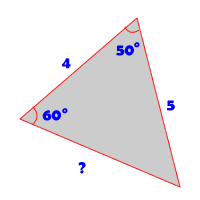Solve for missing parts of a triangle
Question:
If I'm given two side lengths and two angle measures of a triangle, how can I find the remaining side if the Pythagorean Theorem doesn't apply?

Answer:
This is a perfect case for using the Law of Sines. The Pythagorean Theorem won't work because it's not a right triangle. The Law of Sines relates all of the side lengths to the angle measurements of any triangle.
$$ \frac{a}{\sin{A}} = \frac{b}{\sin{B}} = \frac{c}{\sin{C}}$$We can very easily find the missing side by plugging in some of what we do know:
$$ \frac{5}{\sin{60°}} = \frac{c}{\sin{50°}}$$ $$ c = \frac{5*\sin{50°}}{\sin{60°}}$$ $$ c = 4.42 $$In fact, we can find the other angle as well if we just use the formula again. In general, we only need three pieces of information to find the rest. We either need two angles and a side, or two sides and an angle. You might have to use the Law of Sines several times, but keep solving for missing variables until you can solve for the one you need.
It should be noted that sometimes the Law of Sines can give misleading results, leading to angles that are much too large. This will be obvious, because the sum of the angles of the triangle will be greater than 180 degrees. Just be sure to check your work and make sure your angle measures are realistic. For more information on this subject, look at the Wikipedia article on the Law of Sines. They have a nice graphic that shows the possible ambiguity that can result.
